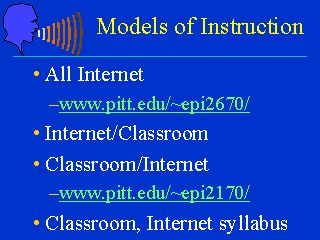One of the first questions that you will face as a teacher is the manner in which you will want to use the Internet for teaching. The Internet thrives upon chaos. In other words, it thrives upon the originality and creativity of itís contributors. In t
his environment, it is safe to say that there is not one model of Internet instruction that is best. You will have room here to develop a course in your fashion.
A look at existing models finds the following examples.
(1) courses that are entirely based upon the Internet. There is very little or no face-to-face contact between the teacher and student. There are different forms of all Internet courses; (a) those with little or no teacher contact with the student; I.e.
the correspondence courses. These include most continuing education courses on the Internet , (b) those with active teacher to student communications. I have recently developed a course on Injury Epidemiology (www.pitt.edu/~epi2670/) that adopts this f
ormat.
(2) Courses that are heavily focused upon the Internet, but include some face-to-face contact between the teacher and the student in a traditional classroom format. In this model, the primary instruction is provided over the Internet, and is supplemented
with face-to-face meetings to review key discussion items. Some distance education programs address this already by having students come to their campuses at the beginning and end of the course.
(3) Courses that rely upon the traditional classroom setting for primary instruction, and use the Internet as a supplement to this instruction. This may include examples such as using Internet sites on the World Wide Web to illustrate lecture points. Ot
hers have provided all of the lecture materials on the Internet for future reference. I have been involved in a class of this nature in Non-Communicable Disease Epidemiology (www.pitt.edu/~epi2170). In this course we put all of the lectures from the cla
ssroom up on the Internet for students to use for review after the lecture.
(4) Courses which use the Internet sparingly. It is quite common to see examples of professors who use the Internet to put the class syllabus online. This is really not Internet-based teaching.









